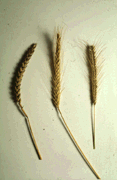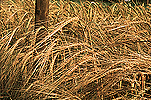Triticale
Grass family (Gramineae)
 |
 |
| Wheat , Triticale , Rye |
|
Source: Bock D., MPI
Distribution, Yield, Use:
- Distribution (in 1986):
The most important countries for cultivation are as Poland (600000 ha),
France (300000 ha), ex-USSR (250000 ha), Australia (160000 ha), Portugal
(80000 ha), USA (60000 ha), Brazil (30000 ha) and Germany (30000 ha). Lower
soil and water requirements than wheat, good resistance to cold.
- Yield:
Under optimal conditions, maximum yields wheat (ca. 90 dt/ha), under less
favourable conditions can be 20-30% higher than wheat.
- Use:
Seeds as animal fodder, seeds as raw material for baking, beer and porridge
10-13% protein in seed, of which 3-4% lysine.

Region of origin:  Region of cultivation:
Region of cultivation: 
- Cultivation and Breeding:
Triticale represents a new kind of cereal, which was developed in the course
of the last hundred years. It is a genus hybrid of tetraploid or hexaploid
wheat (Triticum) as the male plant, and diploid rye (Secale) as the female
in the cross. Since the hybrid progeny are sterile to a high degree, their
chromosome complement must be artificially doubled by treatment of the
seedlings with colchicine, an alkaloid from the Autumn Crocus, in order
to obtain fertile plants. Triticale combines the yield capability and grain
quality of wheat with the winter resistance, undemanding nature and disease
resistance of rye. In the temperate zones, winter varieties are almost
exclusively grown; in the tropics and subtropics, summer varieties are
grown.
- Breeding aims:
The breeding aims include increasing the fullness of the seed, hardy seed
structure, genetic stability, early ripening, stability, resistance to
deformity under damp, resistance to fungal and bacterial disease, adaptation
to particular daylight hour lengths, and improvement of the baking qualities
(dough elasticity, gluten content).
Text by Dr.
Wolfgang Schuchert
Adapted to HTML by R.Saedler



![]() Region of cultivation:
Region of cultivation: ![]()